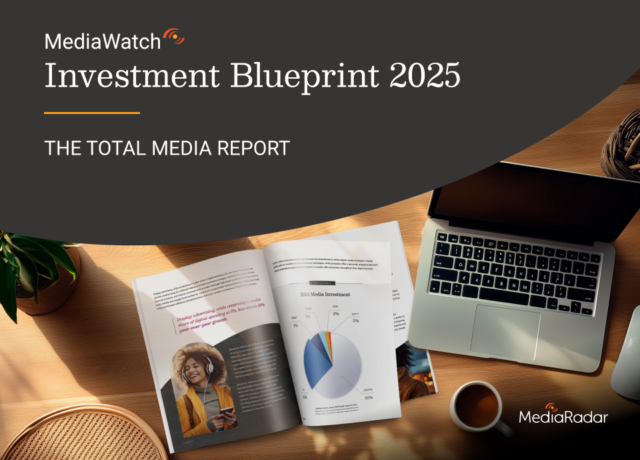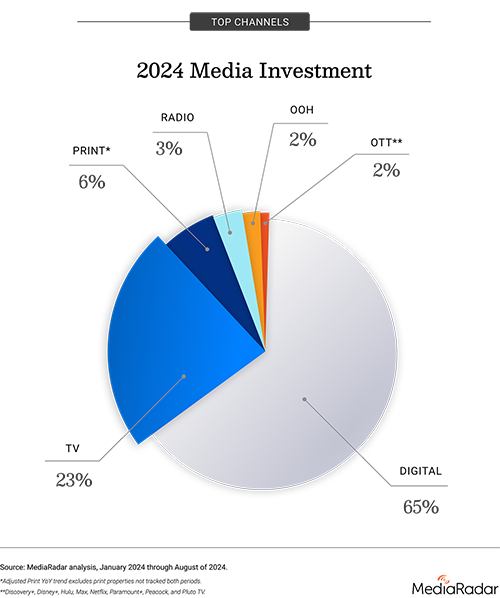
Unlocking the future of advertising: What can we expect from media investments in 2025?
Get a sneak peek into the future with exclusive insights from Meghan Fraze, Chief Product Officer at MediaRadar, Inc., in our latest blog.
In the ever-evolving world of advertising, brands looking to capture consumer attention and drive growth need to stay ahead of the curve. To help advertisers, agencies, and publishers understand what trends are shaping the future of advertising, MediaRadar undertook a comprehensive review of US advertising expenditures across top media channels between January and August 2024 and compared those expenditures to the year before. The analysis revealed important strategic insights for brands looking to make the most of their media investments in 2025 and beyond.
Digital media now captures two-thirds of total media spending
One of the most significant findings from this new analysis is the dominance of digital media. It now captures nearly two-thirds of total media spending in the US, surging 8% year-over-year and reaching $107 billion for the first eight months of the year. Led by paid search, mobile, and paid social, digital media meets consumers where they spend the most time and checks all the boxes for advertisers: seamless engagement, quick conversions, and measurable impact. Brands across industries as varied as home improvement, department stores, automotive, QSRs, software, and financial services are investing heavily in digital channels to reach consumers at every step of their path to purchase.

Traditional media shows signs of resilience
While digital media is growing, traditional media channels are experiencing varied fortunes. Television saw a healthy 3% increase in media spending this year, buoyed by major sporting events like the Olympics as well as political campaigns. However, print media faced a significant decline, dropping 11% overall as advertisers continue to shift their focus to digital platforms and concentrate their print budgets on fewer major publications. Radio remained relatively stable, with local radio seeing slight growth, underscoring its continued relevance for local advertisers as well as national advertisers looking to tailor their messages to local audiences.
The line between traditional and digital is blurring
While most industry reports still count them separately, channels like radio (traditional) and podcasts (digital), or linear TV (traditional) and OTT (digital), are essentially two sides of the same coin these days. Podcast advertising, for instance, offers advertisers a unique opportunity to engage listeners in a personal and targeted manner, and its rapid expansion is a shot in the arm for traditional radio stations and producers willing to bridge the gap. Similarly, OTT promises targeting capabilities advertisers could only dream of with linear TV, and most traditional media companies today are developing streaming offerings to get in the game and safeguard their TV budgets in the process. While the expectation is that linear TV will continue to slide over the next few years, the growth of OTT will more than make up for it, and we anticipate that TV in one shape or another will remain the cornerstone of many companies’ marketing plans.
AI will play both savior and disruptor in 2025
As the advertising ecosystem continues to morph and adapt to complex market realities, advertisers and agencies will increasingly rely on AI and other advanced analytics to enhance campaign design and delivery, and publishers will use it to improve how they monetize their audiences and control ad fraud. But AI will also create new challenges for the industry. For example, on most search engines today, AI-generated answers are taking up much of the top space and pushing traditional search results off the screen. This makes it difficult for sponsored search results to stay visible, especially among young users who are more likely to take AI results at face value. To come out on top in 2025, brands will need to recognize those challenges, not bury their head in the sand.
The future is decidedly omnichannel
As media consumption becomes more fragmented, and consumer attention more divided, advertisers can hardly rely on a single channel anymore to meet their objectives. The future of advertising is decidedly omnichannel. Whether they’re trying to build brand awareness, acquire new subscribers, or close more sales, advertisers today need to spread their action across multiple platforms while ensuring a seamless and integrated brand experience for all their customers and prospects. It’s far from easy, but it’s also very achievable with the right supporting data.










